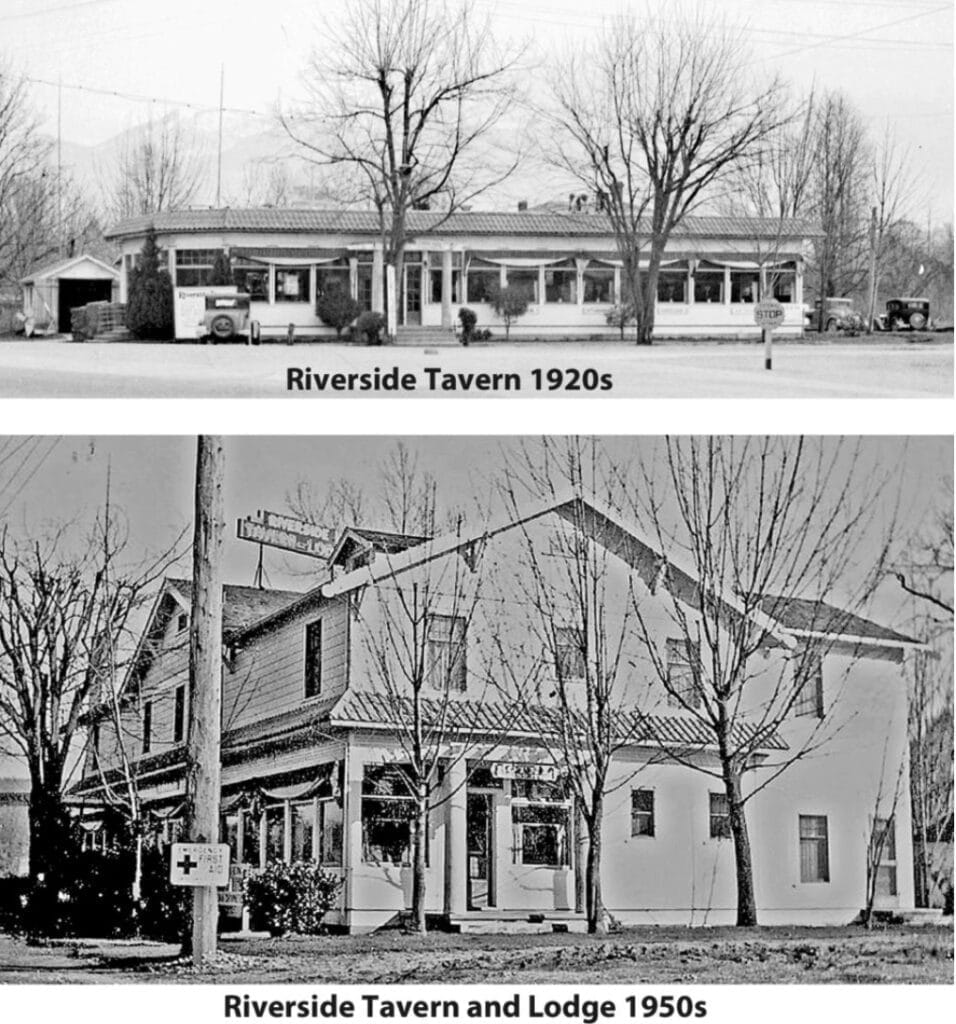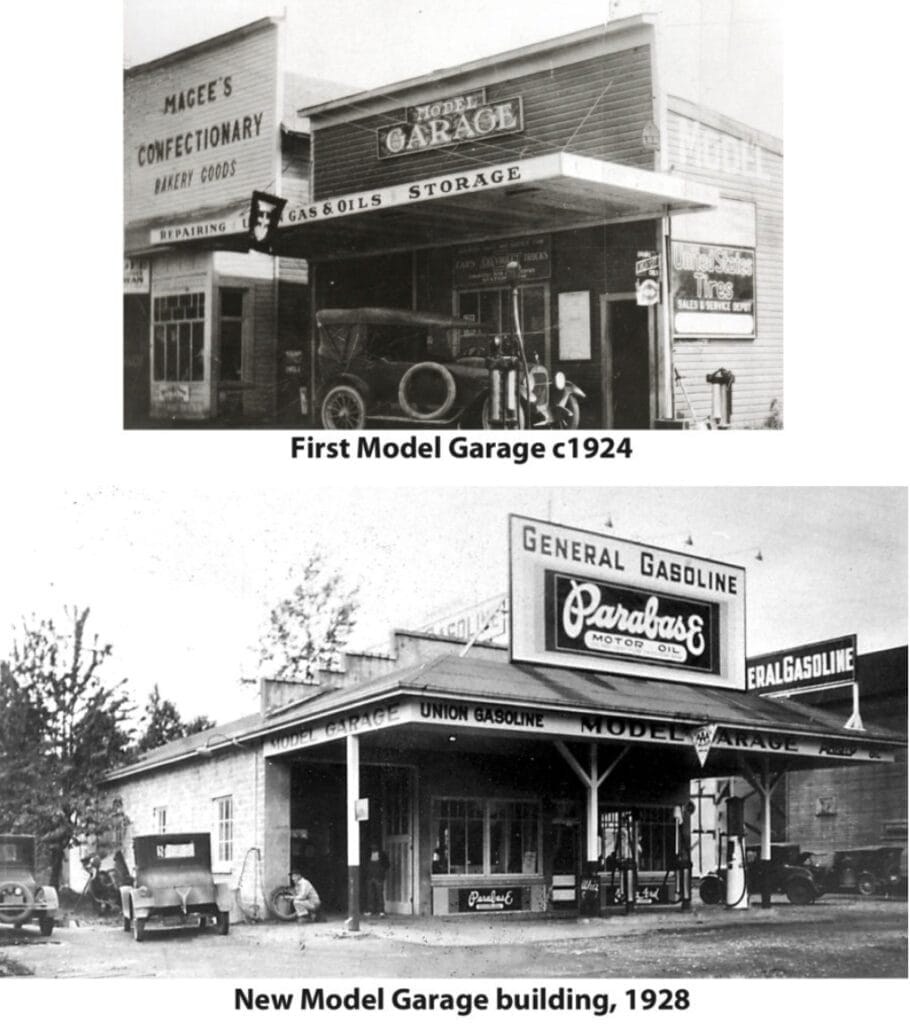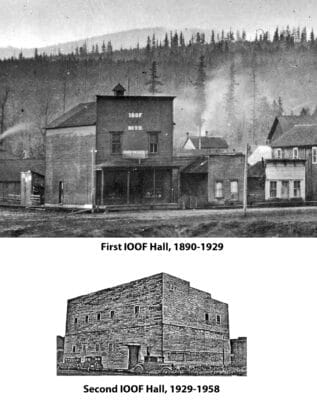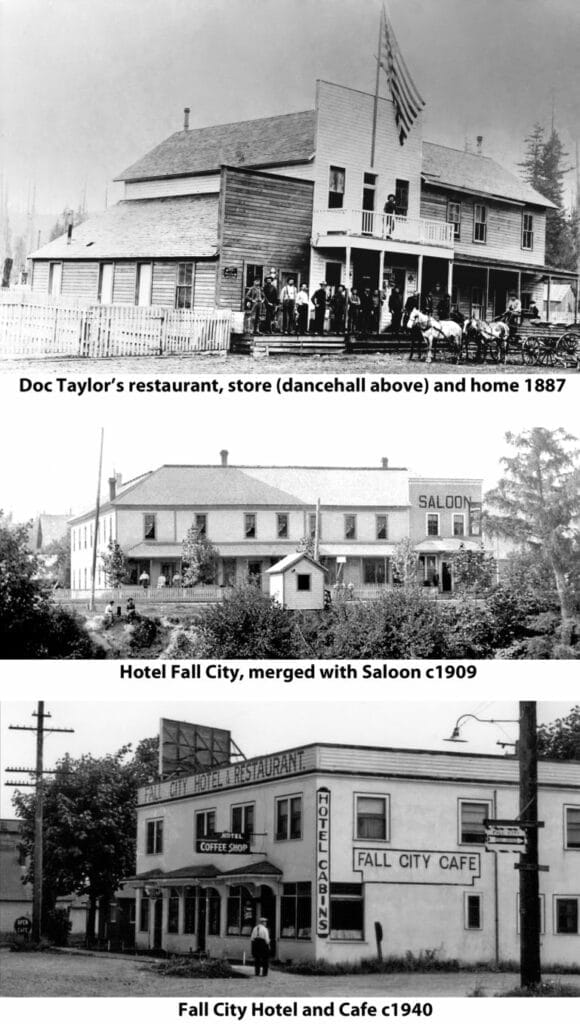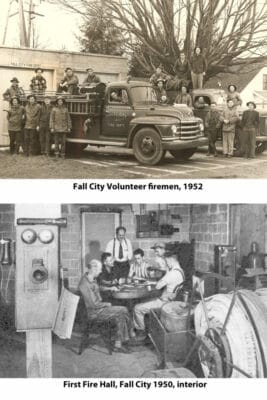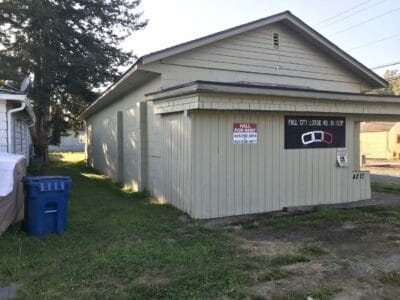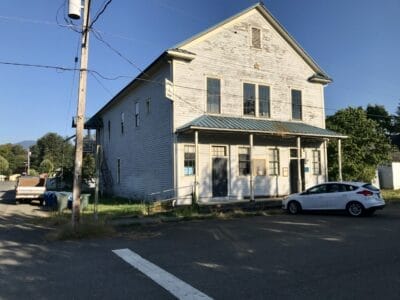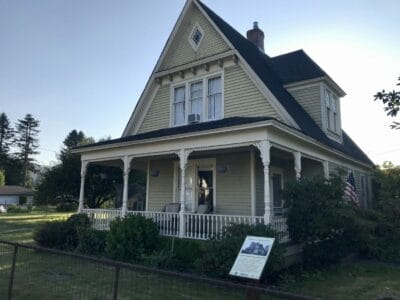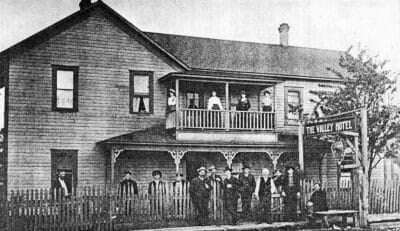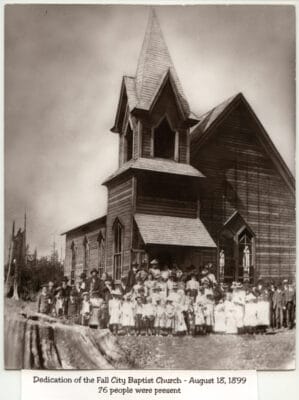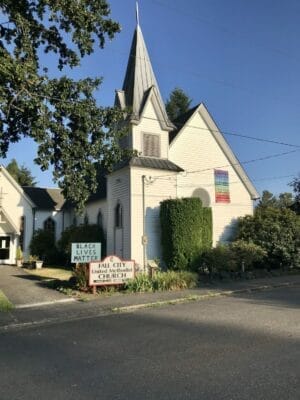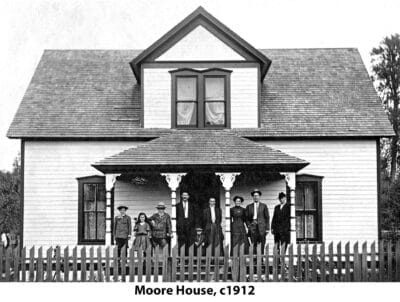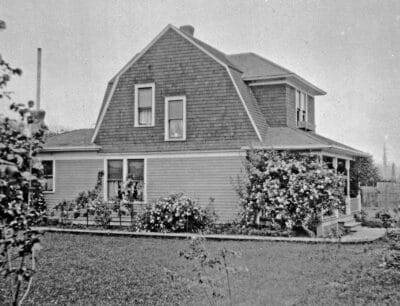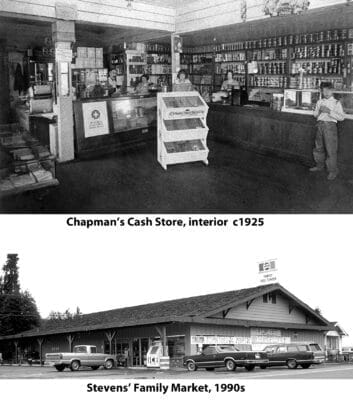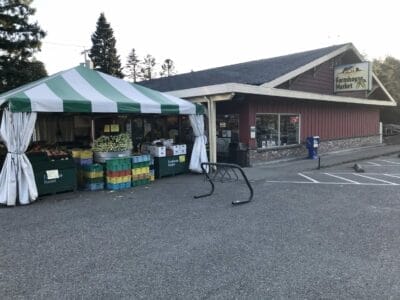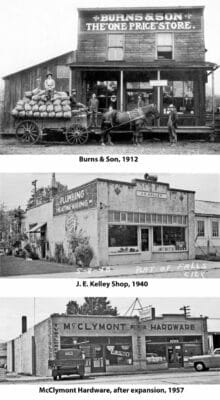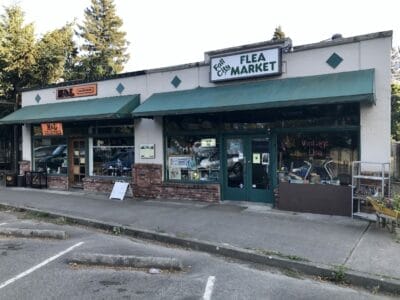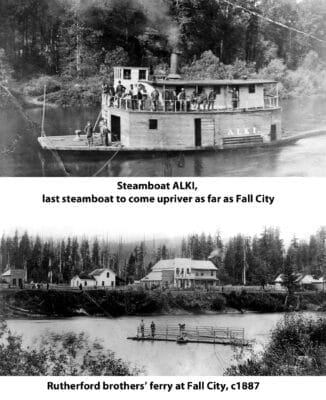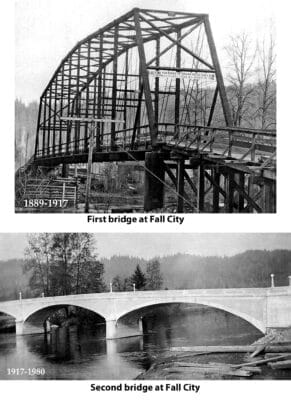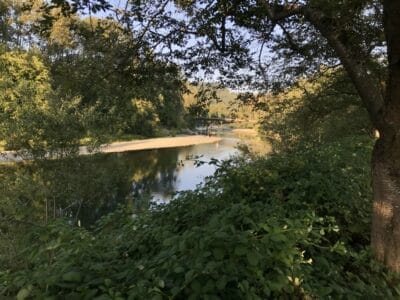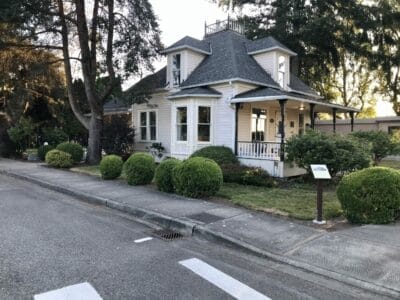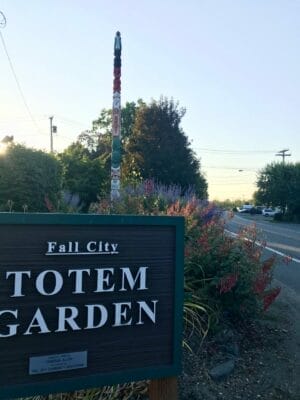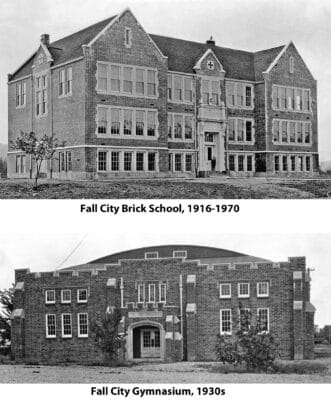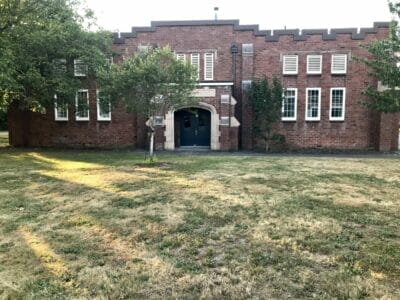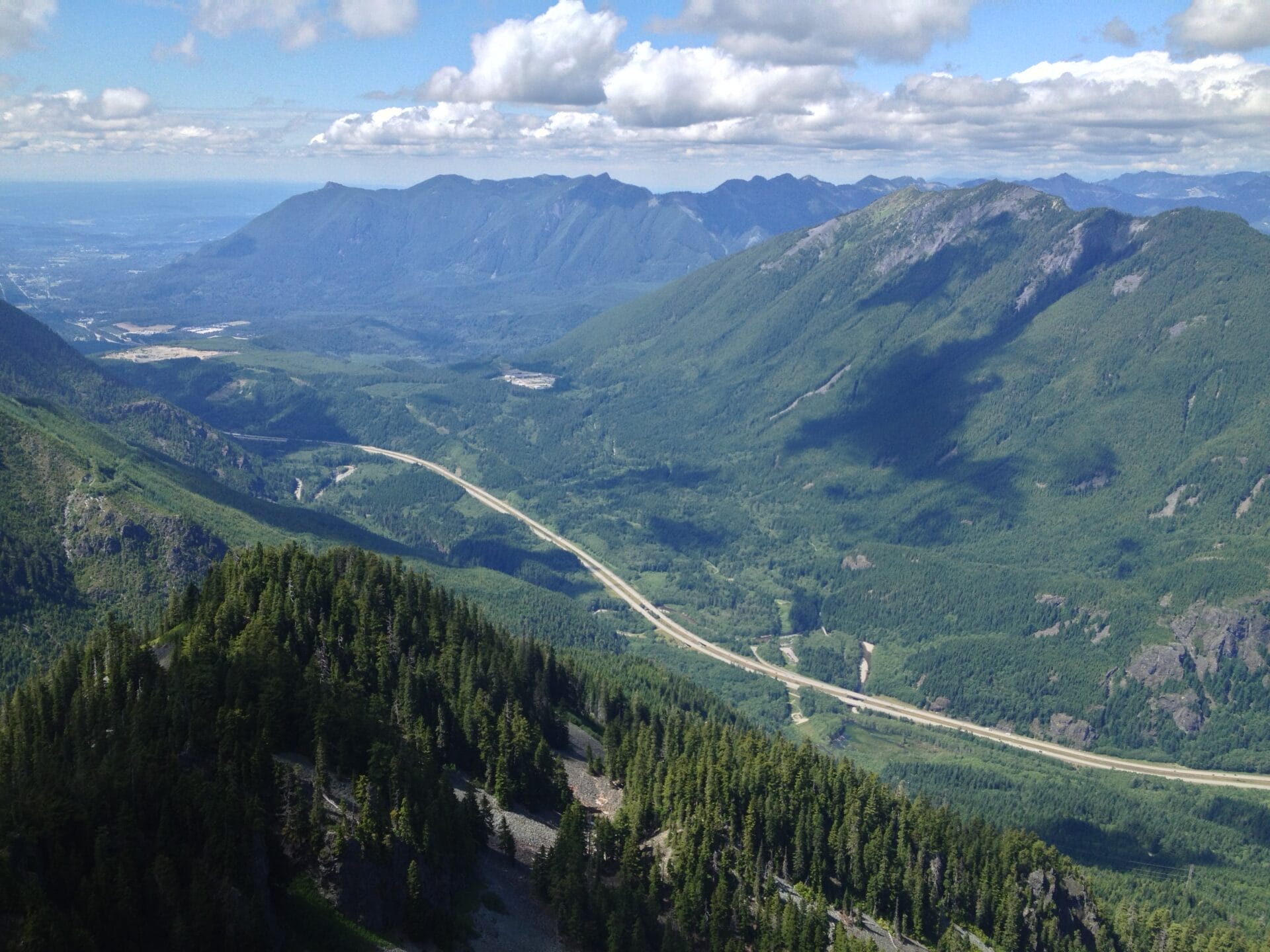Fall City Historic Walking Tour
Enjoy a self-guided stroll through the historic town of Fall City. Learn about a variety of early homes, halls, and businesses, some existing now only in photos and memory. Click on the links to see early photos and for further reading. You can also download and print the Historic Signs Walking Tour Map developed by the Fall City Historical Society.
Itinerary designed with generous support from 4Culture with King County Lodging Tax Funds.
Itinerary
-
The Roadhouse
Start your tour at The Roadhouse. Take time to have coffee or plan to come back to eat after your tour!
Paul Holden built the original single-story Riverside Tavern at this site in 1925, near Riverside Campgrounds and a dance pavilion. Owner Mae Brown added a second story with guest rooms and changed the name to Riverside Tavern and Lodge in 1933. In 1966, Ed DeGrace acquired the building, did some remodeling, and changed the name to the Colonial Inn – a restaurant enjoyed by the community for over twenty years. Scott Krahling of Sammamish and Charlie Kellogg of Fall City purchased the building and business in 2005. After extensive refurbishing, they opened in 2008 as the Fall City Roadhouse. Long-time employees Cynthia Heyamoto and John Manning purchased the Roadhouse in 2018.
-
Mobile Garage
From the Roadhouse, walk south (left) on Preston-Fall City Road to the crosswalk to safely cross that busy street. After crossing, go right for a block and then veer left onto River Street / Highway 202 West / Redmond-Fall City Road. On the left side at 338th Pl SE, sits the Model Garage, Fall City’s longest operating business.
In 1920 Lud Peterson leased an earlier garage on this site and opened the first Model Garage. Around 1926, he purchased the garage building and the large Murphy house that sat on the corner, took down the house, and hired Bill Blaisdell to build a larger 40 x 60 feet cinder block garage on the corner lot. The widening of the Redmond-Fall City Road around 1929 required relocation of the new Model Garage 50 feet south to its current location – one of the few River Street buildings to survive the roadwork. Read more about the Model Garage here.
-
Riverside Tavern
The Riverside Tavern sits across 338th Pl SE from the Model Garage.
From 1890 through 1958 large structures built by the Fall City Lodge No. 59 of the Independent Order of Odd Fellows Halls occupied this corner lot for 68 years. The first IOOF Hall (1890-1929) contained a second story meeting room and a large rental space at street level. Dunstan Brothers General Merchandise occupied the street level space from 1904-1929. The widening of Redmond-Fall City Road in 1929 required demolition of the first hall. IOOF then constructed a second hall (1929-1958) towards the back of the lot. After demolition of the second hall in 1958, the current building replaced it. The Riverside Tavern business moved from its original location (now the Fall City Roadhouse) to this site around 1960.
-
Hotel Corner
Continue west on Redmond-Fall City Road to El Caporal Restaurant, at the corner of 337th Pl SE.
This corner lot, the “Hotel Corner” has hosted a number of hotels and other businesses since the 1880s. Over a couple years beginning around 1886, David ‘Doc’ Taylor built a store here, added a restaurant on the east side, and then added a two-story house for his family on the west side. When these buildings burned down, he built a two-story Taylor Hotel on the lot, which he sold in 1903 to Andrew and Karen Ronnei, and Mike Nelson. They changed the name to Hotel Fall City and added a saloon. The new owners died in the flu epidemic of 1919. Lars and Ingo Johansen bought the building and changed the name to Fall City Hotel; however, it too burned to the ground in 1925. Lars then built a new Fall City Hotel on the site, which he moved to the back of the lot in 1930 when the road was widened. This building has been in continuous use ever since. Read more about the Hotel Corner here.
-
Fall City IOOF Hall
Cross 337th Pl SE and turn left (south) on that street. Just past the alley sits a cinderblock building the Fall City Independent Order of Odd Fellows have used since 1961.
In 1947, the Fall City Fire Department built this small building as Fall City’s First Fire Hall. It housed the fire truck, various pieces of equipment, and space for the volunteer firemen to relax when on shift.
-
Fall City Masonic Hall
Continue south on 337th Pl SE to SE 43rd St. Diagonally across the intersection sits the Masonic Hall.
As the tallest and least altered of Fall City’s buildings from the late 19th century, the Fall City Masonic Hall has served as a visual community landmark for well over 100 years. Chartered in 1890, the Falls City Masonic Lodge No. 66 met initially in the hall above Taylor’s Store on River Street (Stop 4). In 1894 the store burned, destroying all the property and records of the Lodge. The members moved quickly to plan and construct the current hall and held their first meeting there in January 1896. Read more about the Masonic Hall here.
-
Neighbor-Bennett House
Across 337th Pl SE and slightly south sits the Neighbor-Bennett House.
Among the older houses remaining in Fall City, the Neighbor-Bennett House is considered the most elegant for the quality of its detailing. Emerson Neighbor built the house in 1904, and 100 years later in 2004 the National Park Service added it to the National Register of Historic Places. Emerson and his brother owned a general store on River Street and helped establish the town’s telephone service. In 1912, he sold the house to Frank Bennett, who operated a delivery and distribution system for large quantities of milk produced in the area. In the beginning this was by horse and wagon along a rough trail to Tolt (now Carnation), with the 18-mile round trip requiring a relief team of horses. Read more about the Neighbor-Bennett House here.
-
Fall City United Methodist Church
Walk just a bit further south on 337th Pl SE again to the corner of 43rd Pl SE to find the Fall City United Methodist Church and its parsonage.
The large Valley Hotel, built in the late 1890s, occupied this corner in Fall CIty’s early days. It burned in July of 1909 and was not rebuilt.
The original part of the present Fall City Methodist Church building was built in 1899 as the Fall City Baptist Church and sat across 337th Pl SE on part of the large lot belonging to the Neighbor-Bennett House. The Methodists gladly shared the building with the Baptists, having lost their earlier church built on land without a clear title. They subsequently bought the building in 1919 and bought the property across 337th Pl SE in about 1927. In 1929 they moved the church to its current location and turned it to keep the entrance on Main Street (337th Pl SE). In the late 1950s and 1960s additions and remodeling brought the building to its present configuration. Read more about the United Methodist Church here.
-
Moore-Parmlee House
From the church, turn left (east) on SE 43rd Pl and walk one block. The Moore-Parmelee House sits on the southeast corner of the intersection with 338th Pl SE.
Charles and Minnie Moore moved to Preston in 1903 with their five children. In 1905 they bought this lot in Fall City for $40 and built a house with lumber from the Preston Mill, using inexpensive vertical-plank construction. In 1920 they sold the house to Al and Mary Minor, who rented it to others.
Eugene Parmelee and Elizabeth Alexander met in Fall City in the early 1900s and married in 1912. Gene died in 1937, leaving Elizabeth to raise their seven children. In 1943 she arranged to buy the Moore house for $1000 and it has remained in family ownership ever since. Family members painstakingly restored the house from 2002 to 2012. Read more about the Moore-Parmelee House here.
-
Early Schools Block
Turn back west on SE 43rd Pl for two blocks to the corner of 336th Pl SE. Turn left (south) on 336th and watch for a large historic sign on the right.
The historic sign at this location has photos and background on early schools here from 1873 to 1915, before classes moved to the newly constructed Brick School (Stop 17) in 1916. The large “school block” bounded by 335th and 336th Pl SE and SE 43rd and 44th Streets served as home to the White School (1890-1900) and the Brown School (1900-1915). Read more about the early schools here.
-
David 'Doc' Taylor House
Turn back north (towards the river) for a few blocks on 336 Pl SE to Redmond-Fall City Road. Turn right and watch for the Fall City Family Dental Clinic on the right.
The David ‘Doc’ Taylor House is the oldest building on “River Street” and one of the three structures that survived the road widening in 1929. Among the early residents of the area, David ‘Doc’ Taylor, his wife Helen, and their three children were the first to settle as a family, in 1872. When Doc sold the Taylor Hotel in 1903, he built this house for his family. Dentists Sabra and Greg Fawcett have operated the Dental Clinic in the building since 1980.
-
Grocery Corner
Turn back west on Redmond-Fall City Road SE and cross 336th Pl SE to the Farmhouse Market on the southwest corner of the intersection.
This Fall City “Grocery Corner” has seen a series of grocery stores serving the area since 1922 when Chapman’s Cash Store opened, occupying the area where the current parking lot sits. After subsequently housing five additional grocery businesses over the years, the original building burned in 1972 as a total loss. Don Bluher constructed the current building and leased it to Gene and Carol Stevens, who operated the longest continuous business here – Stevens’ Family Market – from 1972 to 2006. In late 2006, Don Bluher’s son Jay stepped in to remodel the building and opened it as the Farmhouse Market in February 2007. Read more about the Grocery Corner here.
-
Macrae Building
Continue west past the Farmhouse Market and watch for the “double” building with brick facing on the front at 33511 Redmond-Fall City Road SE.
This small Macrae Building has a rich history. Burns & Son “One Price” Store (1909-1922) originally occupied the west half of the site. Robert Burns sold the store to his son-in-law Jesse Kelley, who replaced it with a concrete building and offered a variety of construction services from the J. E. Kelley Shop until 1944. Jesse and Artie Kelley then sold the building to Artie’s cousins, Howard and Clara Stow, who operated Stow Hardware here until 1954. New owner Jack McClymont then added the east half to the building and operated McClymont Hardware until 1976. Other hardware operators continued until around 1992. In 1993, Ian Macrae purchased the building which has subsequently housed a variety of businesses. Read more about the Macrae Building here.
-
Snoqualmie River
Continue west a few steps to the crosswalk and carefully cross Redmond-Fall City Road to Quigley Park by the Snoqualmie River.
Fall City’s early settlement stems in large part from its favorable landing spot on the Snoqualmie River. Until railroad transport became available, at first dugout canoes and then steamboats carried goods and materials to and from the Snoqualmie Valley towns. The river saw lively steamboat travel until the late 1880s.
The river offered transport, but also presented an obstacle to travel. Before the construction of bridges, small ferries often assisted in river crossing. A classic early photo of Fall City shows the Rutherford brothers’ ferry, powered by the river current.
Construction of the first of the Snoqualmie River bridges in Fall City was a big event. The wooden bridge, with a span of approximately 350 feet, opened in 1889. It fell in the spring of 1900 and was rebuilt the following year with salvaged materials. The first concrete bridge, with graceful arches, replaced the wooden bridge In 1917. Increased vehicle size and traffic volume necessitated construction of the more substantial current concrete bridge, completed in 1980.
-
Prescott-Harshman House
Carefully use the crosswalk to return to the south side of Redmond-Fall City Road. Cross 335th Pl SE to the carefully-restored Prescott-Harshman House on the corner, now home to Aroma Coffee. From 1912 to 1933 the Prescott-Harshman House served as the home of Newton and Julia Harshman and as the office of their business – the Fall City Telephone Company. The phone company provided vital links among the communities of Carnation, Preston, Fall City, North Bend, Newcastle, Coal Creek and Snoqualmie, and connected them with the “outside world.” After Julia’s death in 1933, her daughter Gertrude and son-in-law George Satterlee continued to operate the company until 1947. Audrey Schroeder completed a meticulous restoration of the home in 1991. Read more about the Prescott-Harshman house here.
-
Fall City Totem Garden
Continue west past the Prescott-Harshman House to the Fall City Library on the left. The Fall City Totem Garden (1934) sits on the small plot of land across from the library.
The official creation of the Fall City Totem Garden in 2006 included installation of two commissioned interpretive signs. One tells the history of the Fall City Totem Poles. Initially installed in 1934 and dedicated to Julia Harshman, deterioration required removal of the original pole in 1981. A second totem pole replaced it from 1982 to 2001. Beginning in 1997, an amazing community effort accomplished the restoration of the original totem pole and its return to the park in 2001.
A second sign in the Garden tells the legend of the pole, as communicated by the original carver, Hugh Hinds of Fall City.
The Totem Garden Park, faithfully maintained by local volunteers, demonstrates the ongoing community spirit in Fall City.
-
Fall City Gymnasium
Continue west on SE 42nd Street from the Totem Garden to the large brick Fall City Gymnasium on the right, and locate the historic sign in front of the gym.
From 1916-1970, the three-story Fall City Brick School sat to the right of the Gymnasium on what is now the parking lot for Fall City Elementary School. Students from kindergarten through high school attended from 1916 to 1944. Only a handful of graduates from the Brick School are still with us. The well maintained Fall City Gymnasium, built in 1931, remains in use today. After the consolidation of Snoqualmie Valley districts in 1944, high school students subsequently attended Mount Si High School. The Brick School continued to house elementary school students until the late 1960s. Demolition occurred in 1970. Read more about the Fall City Brick School here.


